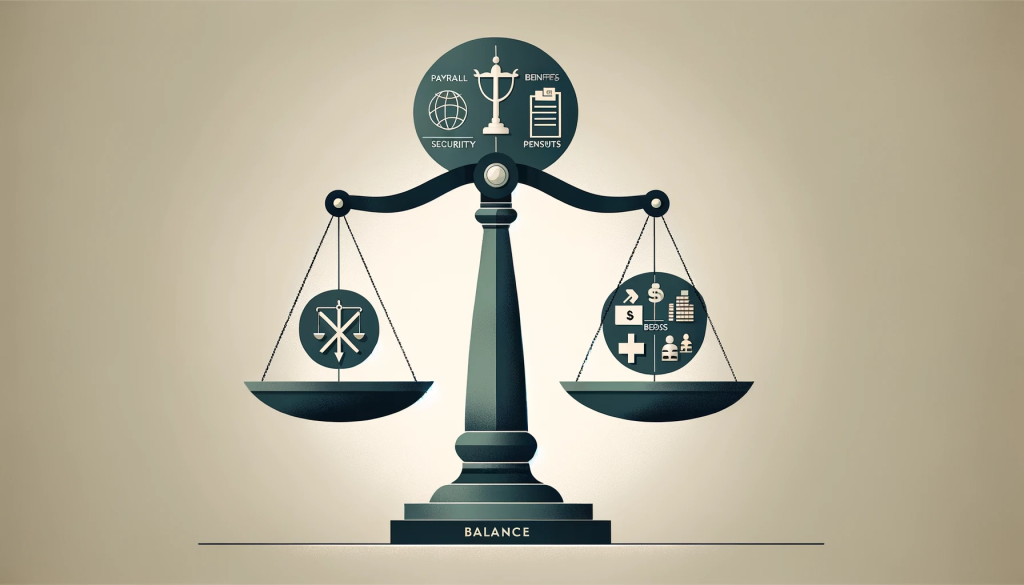The Role of Employment Taxes in Global Economies
Employment taxes, a critical yet often overlooked aspect of the tax system, play a vital role in shaping economies and social welfare systems globally. This article looks into the intricacies of employment-related taxes, highlighting the benefits and challenges of high tax regimes across various countries.
What are Employment Taxes?
Employment taxes are levied on both employers and employees, primarily to finance social insurance programs. In the United States, for instance, these taxes (often referred to as “Payroll taxes”) encompass Social Security, Medicare, and unemployment insurance.
Known collectively under the Federal Insurance Contributions Act (FICA), these taxes are equally shared between the employer and the employee. In 2024, the total FICA rate in the U.S. stands at 15.3%, evenly divided between the two parties.
In contrast, European countries adopt diverse approaches to these taxes. For example, Belgium has one of the highest labor tax burdens at 53%, followed closely by Germany and France, with rates around 47-48%. These taxes are instrumental in funding social programs like health insurance, unemployment insurance, and pensions.
Global Perspectives on Employment-Related Taxes
The implementation and purpose of employment taxes vary worldwide. In OECD countries, these taxes are generally imposed on wage income, in addition to the standard individual income tax. The revenue generated is earmarked for specific social insurance programs, including unemployment and government pension programs, and health insurance.
The labor tax burden, representing the gap between the total cost to the employer and the net income of the employee, serves as a key indicator of the impact of these taxes.
In the following sections, we will analyze the advantages and disadvantages of high employment taxes, drawing on data and case studies from different nations. Our aim is to offer a balanced perspective, enhancing the understanding of these taxes’ role in contemporary economies for a global readership.
Comparing Employment Tax Rates By Country
| Country | Employer Contribution | Employee Contribution | Total Social Security Contribution (%) | Total Tax Burden on Labor (%) | Notable Features |
|---|---|---|---|---|---|
| USA | 7.65% | 7.65% | 15.3% (Capped at $147,000 of income) | Varies by state and income (8% – 58%) | Federal taxes fund Social Security, Medicare, and unemployment insurance. |
| Belgium | Varies, typically high | Varies, lower than employer’s share | Approx. 50-55% (combined) | Around 53% | Among the highest tax burdens in OECD; funds extensive social welfare programs. |
| Germany | Approx. 20% | Approx. 20% | Up to 40% | Around 47-48% | Funds health insurance, unemployment insurance, and pensions; known for its social market economy. |
| France | Over 40% (varies) | Lower than employer’s share, varies | Varies, but high | Around 47% | Similar to Germany, with extensive funding for social programs. |
| Sweden | Approx. 31.42% | No direct payroll tax | Approx. 31.42% (employer only) | Around 48.4% | Strong social safety net; high personal income taxes in lieu of employee payroll taxes. |
| Singapore | Lower than European counterparts | Mandatory savings schemes | Lower than European counterparts | Not specified | Lower payroll taxes with mandatory savings schemes for retirement, healthcare, and housing. |
The Benefits of High Employment Taxes
High taxes, often a topic of debate, can bring several significant benefits to a country’s economy and its citizens. Here’s a concise overview of the key advantages:
- Robust Social Safety Nets: Higher payroll taxes fund comprehensive social welfare programs.
- Economic Stability: They contribute to economic resilience during downturns.
- Reduced Income Inequality: High payroll taxes can help in leveling income disparities.
- Long-Term Benefits for Employees: Ensures secure retirement and healthcare benefits.
- Encouragement of a Healthier Workforce: Through funded healthcare programs.

Robust Social Safety Nets
Countries with high payroll taxes often provide extensive social services, including health care, pensions, and unemployment benefits.
For example, in European nations like Belgium, Germany, and France, where the tax liability on labor is high (ranging around 47% to 53%), these taxes fund health insurance, unemployment insurance, and pension schemes.
The security offered by these comprehensive welfare programs can lead to a higher quality of life and reduced poverty rates.
Economic Stability
High payroll taxes play a pivotal role in stabilizing economies during financial downturns. By ensuring continuous funding for social programs, they provide a safety net that maintains consumer spending and supports economic recovery. This stability is crucial for both individuals and businesses during periods of economic uncertainty.
Reduced Income Inequality
One of the critical roles of high payroll taxes is in reducing income inequality. By redistributing income through social welfare programs, these taxes can help level the playing field between different economic classes.
In countries with progressive tax systems, higher earners contribute a more significant portion of their income to these taxes, which is then used to support essential services for all citizens.
Long-Term Benefits for Employees
High payroll taxes ensure that employees have access to long-term benefits like secure retirement and comprehensive healthcare. These benefits are particularly important as they provide security in old age and access to necessary health services without the burden of high out-of-pocket costs.
The Drawbacks of High Employment Taxes
While high employment taxes have notable benefits, they also come with several drawbacks that can impact both the economy and individual workers. Here are the key disadvantages:
- Financial Burden on Businesses and Employees: Increased costs for employers and lower take-home pay for workers.
- Potential Adverse Effects on Employment and Wages: Could lead to lower employment rates and stagnant wages.
- Impact on Economic Growth: High taxes can potentially slow down economic growth.
Financial Burden on Businesses and Employees
High payroll taxes can significantly increase the financial burden on businesses, particularly small and medium-sized enterprises. This additional cost can lead to higher prices for goods and services, reduced profits, or cuts in other areas such as investment in business expansion or employee benefits.
For employees, higher payroll taxes mean a reduction in net take-home pay, which can lower their disposable income and purchasing power.
Potential Adverse Effects on Employment and Wages
There is a concern that high payroll taxes may negatively impact employment levels. Employers might be hesitant to hire new staff due to the increased costs associated with high payroll taxes. This can lead to higher unemployment rates, especially among certain groups like young or low-skilled workers.
Additionally, there’s a risk that wages could stagnate as businesses might offset the increased tax costs by limiting wage increases.
Impact on Economic Growth
High payroll taxes can potentially slow down economic growth. By reducing the disposable income of workers and increasing the operational costs for businesses, these taxes can lead to decreased consumer spending and lower business investments. This, in turn, can result in a slower rate of economic expansion and a potential reduction in competitiveness in the global market.
In the final section, we will explore how countries can find a balance between the benefits and drawbacks of high payroll taxes, and what future trends might look like in this area. This balanced perspective is essential for understanding the complex dynamics of payroll taxes in modern economies.
Balancing Act – Finding the Middle Ground

Finding the right balance in taxation is crucial for ensuring economic stability and fairness. This section explores the need for a balanced approach, insights from experts, and examples of countries that have successfully managed their payroll tax\ rates.
The Need for a Balanced Approach
A balanced approach to payroll taxation means setting rates that sufficiently fund social programs without overburdening businesses and workers. This balance is vital to maintain economic health and social welfare simultaneously. It requires careful consideration of the impacts on employment, business growth, and the well-being of workers.
Insights from Economic Experts
Economic experts often emphasize the importance of a tax system that is fair, efficient, and sustainable. According to the OECD, efficient tax systems should minimize economic distortions and not discourage work or investment. Experts suggest that payroll taxes should be structured to avoid excessively high marginal tax rates that could deter people from working or businesses from hiring.
Optimal tax rates vary depending on the country’s social needs and economic conditions. Some economists advocate for a progressive tax system, where higher earners pay a larger percentage, to reduce income inequality without discouraging low-income earners from entering the workforce.
Successful Examples from Various Countries
Different countries have adopted various strategies to balance their payroll taxes effectively:
- Sweden: Known for high taxes, Sweden has worked to balance this with a strong social safety net and public services. Despite high labor taxes, Sweden has a relatively high labor market participation rate, suggesting that its tax system, while robust, does not overly discourage employment.
- Singapore: Singapore offers an example of lower payroll taxes combined with mandatory savings schemes like the Central Provident Fund, which provides for retirement, healthcare, and housing needs. This approach balances lower immediate tax burdens with long-term social security.
- Germany: Germany has a social market economy, where payroll taxes fund extensive social programs. Germany has managed to maintain a strong economy and low unemployment rates, indicating a balanced approach in managing payroll taxes and social welfare benefits.
Final Thoughts
The key to successful employment taxation lies in finding a balance that supports both economic growth and social welfare. Countries must continuously adapt their tax policies to changing economic conditions and societal needs, learning from both domestic experiences and international best practices.




